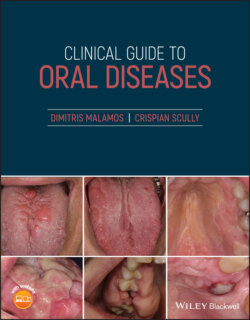Читать книгу Clinical Guide to Oral Diseases - Crispian Scully - Страница 15
Case 1.1
ОглавлениеFigure 1.1a
Figure 1.1b
CO: A 62‐year‐old woman was referred by her family doctor for evaluation of several red spots on her lips, mouth, and the skin of her fingers.
HPC: The red spots had been present since childhood, but had become greater on the surface of her face over the last five years causing cosmetic problems and patient’s concern.
PMH: Her medical history revealed a chronic iron deficiency anemia which still remained despite the fact that the patient was in the post‐menopause phase and had been treated occasionally with iron tablets. No other serious medical problems were recorded except for a few episodes of nose and gut bleeding which had caused her to ask for medical advice. She was a non‐smoker and non‐drinker.
OE: The examination revealed numerous red vascular papules, variable in size, ranging from pin head‐like lesions to small red plaques at the vermilion border of her lips, and on the tongue and buccal mucosae (Figure 1.1a). A few asteroid‐like red lesions, were also seen on the skin of her fingers (Figure 1.1b) and inside her nose which were responsible for her episodes of epistaxis.
Q1 Which is the possible cause of her red spots?
1 Crest syndrome
2 Sjogren syndrome
3 Rendu‐Osler‐Weber syndrome
4 Rosacea
Ataxia‐telangiectasia
Answers:
1 No
2 No
3 Rendu‐Osler‐Weber syndrome or hereditary hemorrhagic telangiectasia (HHT) is a rare autosomal dominant condition that affects blood vessels throughout the body (telangiectasia; arteriovenous malformations) with a tendency for bleeding. This vascular dysplasia is commonly seen in oral, nasopharynx, lung, liver, spleen, gastrointestinal and urinary tracts, conjunctiva and the skin of arms and fingers.
4 No
5 No
Comments: Skin telangiectasias are also seen in patients with ataxia telangiectasia, Crest and Sjogren syndromes. In rosacea, main vascular lesions are the broken vessels that are located exclusively on the skin predominantly on the middle of the face, as in ataxia telangiectasia. In ataxia telangectasia, the vascular lesions are associated with poor coordination, and in Crest syndrome with calcinosis and sclerodactyly and Raynaud phenomenon. Sjogren's syndrome affects the mouth, eyes, nose and other organs causing dryness, swelling of the salivary glands and facial telangiectases.
Q2 Which are the main complications of this condition?
1 Anemia
2 Pulmonary hemorrhage
3 Ischemic stroke
4 Skin photosensitivity
5 Mental retardation
Answers:
1 Iron deficiency anemia is a very common complication induced by a series of episodes of blood loss through the nose (epistaxis) and gastrointestinal tract (melena stools) from telangiectic lesions.
2 Pulmonary hemorrhage is mainly found in patients older than 40 years old and with multiple visceral involvements, causing breathing problems, portal hypertension and liver cirrhosis.
3 Ischemic stroke is a rare yet serious complication in patients with HHT, and requires special care.
4 No
5 No
Comments: The vascular lesions on facial skin sometimes cause cosmetic problems, but never skin photosensitivity, while the brain lesions of HHT may cause neuro‐psychiatric complications with various pathways which have not been related to mental illness before.
Which genes are linked with this condition?
1 Endoglin gene (ENG)
2 Fibroblast growth factor receptor 3 (FGFR3)
3 Activin receptor like kinase (ALK‐1)
4 Collagen type I alpha 1 chain(COL1A1)
5 Dentin sialophosphoprotein (DSPP)
Answers:
1 Engoglin gene mutations have been isolated in HHT families (type 1)
2 No
3 Activin receptor like kinase (ALK‐1)mutations have been found in HHT (type 2)
Comments: Mutations in the COL1A1 and COL1A2 genes are related to the development of the majority of osteogenesis imperfecta (>90%), while FGFR3 is associated with fibrous dysplasia and DSPP with dentinogenesis imperfecta.
The following abbreviations are used throughout the book – CO: Complains of; HPC: History of present complaint; PMH: Past medical history; OE: oral examination.
